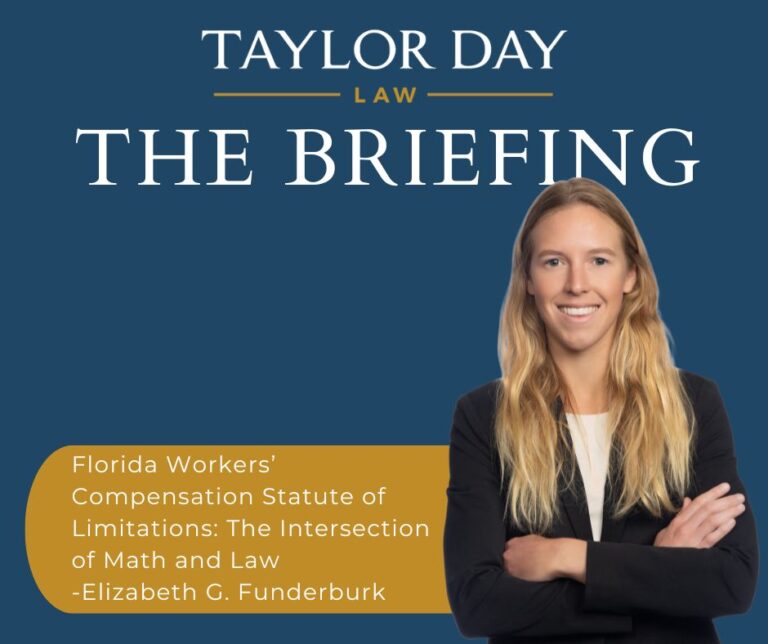An important aspect of every Florida workers’ compensation claim is the calculation of the statute of limitations. “Statute of limitations” may sound like a fancy legal term; however, it is simply a provision in the workers’ compensation law that specifies the time period in which an injured worker must file a Petition for Benefits to prevent their claim from being time-barred. On the flip side, the statute of limitations can be used by the Employer/Carrier as a defense to deny a claim when the injured worker waits too long to file a Petition. Therefore, it is imperative that Employer/Carriers understand how the statute of limitations operates and case law that may affect a Judge of Compensation Claims’ analysis of the calculation of the limitations period under this provision.
In Florida, the statute of limitations that applies to workers’ compensation claims is contained in Florida Statute 440.19. This provision states in relevant part that “all employee petitions for benefits shall be barred unless… the petition is filed within 2 years after the date on which the employee knew or should have known that the injury or death arose out of work performed in the course and scope of employment” (Fla. Stat. 440.19(1)). Further, the statute contains a tolling provision of one year for “payment of any indemnity benefit or the furnishing of any remedial treatment, care, or attendance” (Fla. Stat. 440.19(2)). Since the 1994 amendments to the Florida workers’ compensation statute, it was understood that, to be timely, a Petition for Benefits must be filed within two years of the date of the accident or within one year of the last payment of indemnity benefits or furnishing of medical treatment, if outside of the two-year post-accident period. Until recently, the case law was well-settled on the application of the two-year initial post-accident period and one-year tolling period, if applicable. If a Petition was filed outside of this window, the Employer/Carrier could raise the statute of limitations as an affirmative defense in its initial response to the Petition.
Seems fairly straightforward, right? Well, recent case law from the First District has caused JCCs to reconsider how they approach the calculation of the time periods contained in the statute of limitations. Although the language of the statute itself has not changed since 1994, the interpretation and application of the two-year limitations period and one-year tolling provision have been reevaluated. In Ortiz v. Winn-Dixie, Inc. (Fla. 1st DCA 2023), also referred to as Ortiz I, the First District interpreted the statute of limitations period to include a complicated master clock and timer. Essentially, the Court decided that each time indemnity or medical benefits were provided, the initial two-year period was tolled for one year. This application of this understanding of the statute could potentially extend the statute of limitations period much longer than the traditional approach. Ultimately, the First District granted a motion for rehearing of its decision in Ortiz I and substituted its opinion in Ortiz v. Winn-Dixie, Inc. (Fla. 1st DCA 2024), also referred to as Ortiz II, for its original opinion. Therefore, Ortiz I is not a binding authority for JCCs, and Ortiz II was not decided based on the statute of limitations issue. However, the concurrence in Ortiz II supports the new master clock and tolling timer calculation of the statute of limitations.
Since the Ortiz I and II decisions, JCCs have applied both the traditional and new approaches to analyzing whether a Petition is time-barred by the statute of limitations. While some JCCs acknowledge that a concurring opinion from the First District is not binding authority and continue to rely on case law supporting the traditional calculation of the statute of limitations period, other JCCs find the new rationale from the Ortiz opinions persuasive enough to apply the new method of calculation. The current instability involving the application of the timing period makes it difficult for Employer/Carriers to determine when they may have a valid defense to an injured worker’s claim. However, despite the case law being unsettled regarding the method of timing calculation, the requirement has not changed that the Employer/Carrier must assert its statute of limitations defense in its first responsive pleading to the Petition or else the defense is waived. (Fla. Stat. 440.19(4)). An Employer/Carrier’s best course of action is to calculate the statute of limitations period under both the traditional and Ortiz approaches and assert its defense based on the earliest date the statute could expire to avoid losing the defense altogether.

